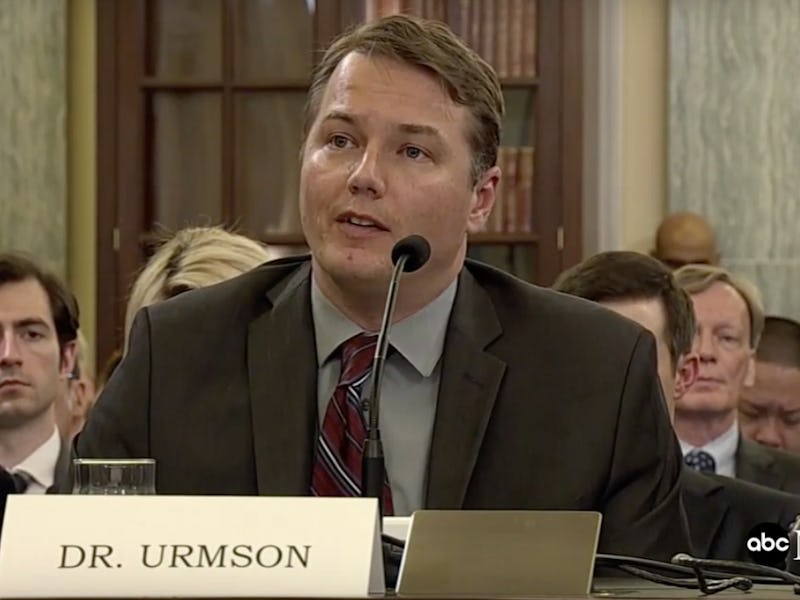Google's Self-Driving Car Chief Tells Congress Foreign Firms Are "Hot on Our Heels"
And that they need some hands-off legislation to really get rolling.

Leaders at Google, General Motors, Delphi Automotive, Lyft, and the director of Duke Robotics took driverless car technology to Washington today to impart on lawmakers that the federal government needs to loosen up driverless car regulations if they want the country to stay at the forefront of innovation.
After all, Google’s competing with countries in Europe, along with Japanese and Chinese companies, to fully develop the first self-driving car.
“They’re hot on our heels,” said Chris Urmson, who heads up Google’s Self-Driving Car Project. “Not a day goes by that a company from China doesn’t try to recruit our team and poach our talent. We need to see the economic benefits and others in America first.”
Urmson went on to say that that self-driving cars could help in reducing the effects of a national problem: the number of fatal traffic collisions.
“When we look at the 38,000 people that [the National Highway Traffic Safety Administration] estimates were killed last year on America’s roads, it’s really an unacceptable status quo,” Urmson said. “And there’s so much opportunity to do good here. Now, the technology will never be perfect, but the opportunity to reduce those accidents and those tragedies is incredible.”
An example of “not perfect” took place last month when Google’s first self-driving car fender bender occurred.
The hearing, titled “Hands Off: The Future of Self-Driving Cars,” put the country’s top autonomous car manufacturers and thinkers in front of congressmen who seemed generally excited about the future of driving, but also a little confused about how we’re going to get there. Urmson along with Mike Ableson of General Motors, and Glen DeVos from Delphi Automotive were on repeat for much of the meeting stating that safety is the top priority.
The technology, Urmson emphasized, would eliminate crashes that stem from driver fatigue, distracted driving, and drunk driving. Driving high would also become less of a problem, Senator John Thune of South Dakota said.
“There are lots of reasons why people are moving to Colorado,” Thune interjected when the senator from Colorado was speaking (Thune was definitely referencing weed.) “We may need more autonomous cars for places like that!”
Jokes aside, the technology does have the potential to drastically reduce accidents and give more people the opportunity to travel. From people who can’t afford all of the costs associated with getting licensed and owning a car to the “silver surge” of Baby Boomers who will lose their license in the foreseeable future, autonomous cars can fill the gap.
That’s where GM and its new partner Lyft come in: Joseph Okpaku, GM’s vice president of government relations, made it clear that with the car-maker’s recent investment in the company, it’s in a unique position to transition the country into using self-driving cars in the same way they helped transition the country into ride-sharing.
Ableson backed him up, saying that the high costs of autonomous cars would keep many people from accessing the technology if it weren’t for ride-sharing. The timing, Ableson says, completely depends on how fast the government can standardize regulations.
Addressing safety, Dr. Mary Cummings of Duke University played the (Blue) Devil’s advocate, saying that the technology just isn’t advanced enough for unpredictable road conditions when there are both human-driven and self-driven cars on the road. She believes that the government needs to come down harder on the companies in order to maintain control of a potentially dangerous technology.
“There is no question that someone is going to die using this technology,” Cummings said. “The question is when. If a death were to occur at the wrong time, it could really set back the future of the technology. We want the safety testing data out there so that the accident that could have been prevented does not happen.”
The companies, on the other hand, sidestepped direct answers on what exactly should be bottom-line privacy and cybersecurity regulations.
“The best action,” Urmson said, “is to take no action.” The states that haven’t taken direct action are where the technology can be best used. What he wants is for federal government to make sure city, county, and state laws don’t get in the way.
Watch the full hearing here: